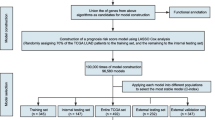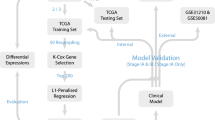Abstract
Squamous cell carcinoma of the lung (SCCL) is the most common and aggressive lung tumor with poor clinical outcome. Identification and development of potential genes in prognostic process could be beneficial for clinical management. Sequencing data of 300 SCCL samples at level 3 were downloaded from The Cancer Genome Atlas (TCGA) data portal. Single-factor survival analysis was performed by the Kaplan-Meier method. Functional annotation was conducted on the high-frequency genes filtered out by 1000 times of the least absolute shrinkage and selectionator operator regression analysis. Meanwhile, multi-factor survival analysis was conducted and ROC curve were produced. Risk coefficient and expression level of each gene were used in the division of high-risk and low-risk genes. The number of high-risk genes of each sample was obtained, and the survival condition of different samples was analyzed. Finally, the number of optimal high-risk genes was obtained. Seven thousand nine hundred ninety-eight differential expressed mRNAs were obtained, and 2041 potential prognostic genes were screened out. Twenty one of the 22 high-frequency genes were showed to have significant impact on prognostic process. Single-factor analysis was performed on the 22 models, and eight efficient models were obtained, and seven among them were proven to be significant. By random testing, ≥5 genes and ≥6 genes were proven to be most stable and ≥6 genes were finally recognized as the beneficial indicator to distinguish lung squamous cell carcinoma. Twenty-two potential genes differentially expressed in lung squamous cell carcinoma were identified as potential prognostic indicator in clinical outcome, and the novel model in this study could be applied in other cancer types.




Similar content being viewed by others
References
Levi F, Maisonneuve P, Filiberti R, La Vecchia C, Boyle P. Cancer incidence and mortality in Europe. Soz Präventivmed. 1989;34:S3–83.
Siegel RL, Miller KD, Jemal A. Cancer statistics, 2015. CA Cancer J Clin. 2015;65:5–29.
Haura EB, Zheng Z, Song L, Cantor A, Bepler G. Activated epidermal growth factor receptor–stat-3 signaling promotes tumor survival in vivo in non-small cell lung cancer. Clin Cancer Res. 2005;11:8288–94.
Sanchez‐Palencia A, Gomez‐Morales M, Gomez‐Capilla JA, Pedraza V, Boyero L, Rosell R, et al. Gene expression profiling reveals novel biomarkers in nonsmall cell lung cancer. Int J Cancer. 2011;129:355–64.
Vavalà T, Levra MG, Novello S. Lung cancer in never smokers: a different disease. Curr Respir Care Rep. 2014;3:26–34.
Sato M, Shames DS, Gazdar AF, Minna JD. A translational view of the molecular pathogenesis of lung cancer. J Thorac Oncol. 2007;2:327–43.
Zudaire I, Lozano MD, Vazquez M, Pajares MJ, Agorreta J, Pio R, Zulueta JJ, Yankelevitz D, Henschke C, Montuenga LM. Molecular characterization of small peripheral lung tumors based on the analysis of fine needle aspirates. 2008.
Wistuba II, Berry J, Behrens C, Maitra A, Shivapurkar N, Milchgrub S, et al. Molecular changes in the bronchial epithelium of patients with small cell lung cancer. Clin Cancer Res. 2000;6:2604–10.
Sekine I, Saijo N. Novel combination chemotherapy in the treatment of non-small cell lung cancer. Expert Opin Pharmacother. 2000;1:1131–61.
Jemal A, Siegel R, Ward E, Murray T, Xu J, Smigal C, et al. Cancer statistics, 2006. CA Cancer J Clin. 2006;56:106–30.
McLendon R, Friedman A, Bigner D, Van Meir EG, Brat DJ, Mastrogianakis GM, et al. Comprehensive genomic characterization defines human glioblastoma genes and core pathways. Nature. 2008;455:1061–8.
Harpole DH, Herndon JE, Wolfe WG, Iglehart JD, Marks JR. A prognostic model of recurrence and death in stage I non-small cell lung cancer utilizing presentation, histopathology, and oncoprotein expression. Cancer Res. 1995;55:51–6.
O’Quigley J, Moreau T. Cox’s regression model: computing a goodness of fit statistic. Comput Methods Prog Biomed. 1986;22:253–6.
Tibshirani R. The lasso method for variable selection in the cox model. Stat Med. 1997;16:385–95.
Goeman JJ. L1 penalized estimation in the cox proportional hazards model. Biom J. 2010;52:70–84.
Huang DW, Sherman BT, Lempicki RA. Systematic and integrative analysis of large gene lists using DAVID bioinformatics resources. Nat Protoc. 2008;4:44–57.
Heagerty PJ, Lumley T, Pepe MS. Time-dependent roc curves for censored survival data and a diagnostic marker. Biometrics 2000: 337–344.
Volinia S, Croce CM. Prognostic microRNA/mRNA signature from the integrated analysis of patients with invasive breast cancer. Proc Natl Acad Sci. 2013;110:7413–7.
Yanaihara N, Caplen N, Bowman E, Seike M, Kumamoto K, Yi M, et al. Unique microRNA molecular profiles in lung cancer diagnosis and prognosis. Cancer Cell. 2006;9:189–98.
Raponi M, Dossey L, Jatkoe T, Wu X, Chen G, Fan H, et al. MicroRNA classifiers for predicting prognosis of squamous cell lung cancer. Cancer Res. 2009;69:5776–83.
Walter K, Holcomb T, Januario T, Du P, Evangelista M, Kartha N, et al. DNA methylation profiling defines clinically relevant biological subsets of non-small cell lung cancer. Clin Cancer Res. 2012;18:2360–73.
Near RI, Zhang Y, Makkinje A, Borre PV, Lerner A. And‐34/bcar3 differs from other NSP homologs in induction of anti‐estrogen resistance, cyclin D1 promoter activation and altered breast cancer cell morphology. J Cell Physiol. 2007;212:655–65.
Tan X, Qin W, Zhang L, Hang J, Li B, Zhang C, et al. A 5-microRNA signature for lung squamous cell carcinoma diagnosis and hsa-mir-31 for prognosis. Clin Cancer Res. 2011;17:6802–11.
Nevins JR, Harpole D, Potti A, West M, Dressman H. Prediction of lung cancer tumor recurrence. Google Patents, 2007.
Hirsch FR, Varella-Garcia M, Bunn PA, Di Maria MV, Veve R, Bremnes RM, et al. Epidermal growth factor receptor in non-small-cell lung carcinomas: correlation between gene copy number and protein expression and impact on prognosis. J Clin Oncol. 2003;21:3798–807.
Volm M, Koomägi R, Mattern J. Prognostic value of vascular endothelial growth factor and its receptor flt‐1 in squamous cell lung cancer. Int J Cancer. 1997;74:64–8.
McKee ML, Kerwin SM. Synthesis, metal ion binding, and biological evaluation of new anticancer 2-(2′-hydroxyphenyl) benzoxazole analogs of uk-1. Bioorg Med Chem. 2008;16:1775–83.
Williams RJ. Metal ions in biological systems. Biol Rev. 1953;28:381–412.
Author information
Authors and Affiliations
Corresponding author
Rights and permissions
About this article
Cite this article
Duan, K., Li, L., Tan, Xd. et al. A novel model for identification of prognostic indicator for clinical outcome of squamous cell lung carcinoma. Tumor Biol. 37, 15873–15881 (2016). https://doi.org/10.1007/s13277-016-5407-1
Received:
Accepted:
Published:
Issue Date:
DOI: https://doi.org/10.1007/s13277-016-5407-1




